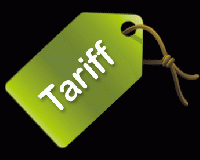
The World Trade Organisation stands for the removal or reduction of trade barriers. It identifies two important trade barriers – quota and tariff. Quota is a trade policy tool where a country stipulates that only a limited quantity of a particular commodity can be imported during a year.
On the other hand, tariff is a tax on the import of a commodity.
According to WTO, quota is more dangerous than tariff as it restricts the quantity of imports severely. Hence WTO asks members to remove quota and impose tariff up to a permissible level. This permissible maximum level is often referred as bound rate.
Bound rate is the maximum rate of duty (tariff) that can be imposed by the importing country on an imported commodity. Here, each country commits itself to a ceiling on customs duties (tariff) on a certain number of products.
These rates vary from country to country and commodity to commodity. But no country can raise duties above the bound rate it has committed, and the rate of customs duty actually applied may be lower than the bound rate.
For a member country like India, the bound rate will be maximum for the commodities it produces less or in which India is not a prominent producer. On the other hand, the bound rate will be low if India is a major producer of a commodity.
The purpose of setting such a tactic is to compel countries to reduce tariff and promote trade. For example, if India is a net importer of a commodity its bound rate will be high. But India will not impose such a high rate as it will injure the consumers.
Similarly, India would like to check the import of those commodities in which it is a leading producer. But here, according to WTO, India should keep only low tax to promote trade and competition. Altogether, tariff will remain low in these two conditions. That is the objective of WTO as an institution standing for the promotion of international trade.
*********









